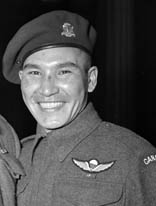
Tommy Prince
This week we have had many conversations around Indigenous Veterans Day (Nov. 8) and Remembrance Day (Nov. 11). We unpacked why citizens sign up to fight for their country, why countries enter into wars and some of the positive and negative stereotypes our society has of soldiers. We then learned about the contributions to the Canadian military from different groups of soldiers who, for a very long time, did not receive the recognition they deserved including our Indigenous veterans. We learned about the heroism displayed by Tommy Prince and the Cree Code Talkers who were instrumental in helping the Allies win the Second World War. Similarly, the contributions by Native American Code Talkers from the Choctaw nation were also crucial in helping to win the First World War. Learn more about them below! As we take some time today to remember the ultimate sacrifice made by our veterans, we must also consider ways we can continue to support them once they have returned home.
 about how Diwali is celebrated both in India and abroad. While there are several important parts that make up this popular celebration including lighting diyas, one of the special aspects of Diwali is the creation of Rangolis. Rangoli is an art form that uses symmetry, geometric shapes, and vibrant colours to create intricate patterns. During the celebration of Diwali, Rangolis are used as a decoration drawn on the floor, typically at the entrances of homes, as they are thought to bring good luck and prosperity to the families that live there. While Rangoli is often created using coloured sand, we have created our own unique versions using various materials.
about how Diwali is celebrated both in India and abroad. While there are several important parts that make up this popular celebration including lighting diyas, one of the special aspects of Diwali is the creation of Rangolis. Rangoli is an art form that uses symmetry, geometric shapes, and vibrant colours to create intricate patterns. During the celebration of Diwali, Rangolis are used as a decoration drawn on the floor, typically at the entrances of homes, as they are thought to bring good luck and prosperity to the families that live there. While Rangoli is often created using coloured sand, we have created our own unique versions using various materials.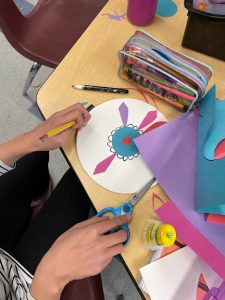


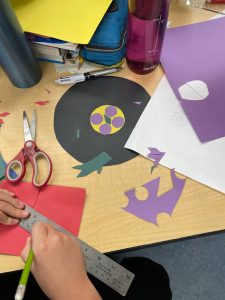
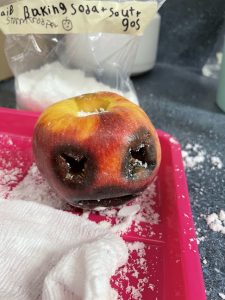 a combination of both!) would create the perfect mummy. We discussed how ancient Egyptians would use natron to remove moisture from and preserve the bodies that we now find deep within the pyramids. When creating our mummified apples, we had the option to wrap our apples in gauze to create a true mummy effect. We have been patiently waiting and making detailed observations for over three weeks to see how our apples have changed.
a combination of both!) would create the perfect mummy. We discussed how ancient Egyptians would use natron to remove moisture from and preserve the bodies that we now find deep within the pyramids. When creating our mummified apples, we had the option to wrap our apples in gauze to create a true mummy effect. We have been patiently waiting and making detailed observations for over three weeks to see how our apples have changed. associated with gender and how these can negatively impact our self-image and the self-image of others. We will continue to discuss how these negative stereotypes can also be based off of our race, class, ethnicity, sexuality and religion. Halloween is a fantastic time to continue these conversations around choosing fun costumes while still being respectful toward all people.
associated with gender and how these can negatively impact our self-image and the self-image of others. We will continue to discuss how these negative stereotypes can also be based off of our race, class, ethnicity, sexuality and religion. Halloween is a fantastic time to continue these conversations around choosing fun costumes while still being respectful toward all people. nuts in the ingredient
nuts in the ingredient 

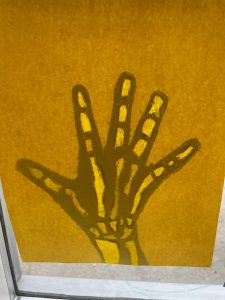
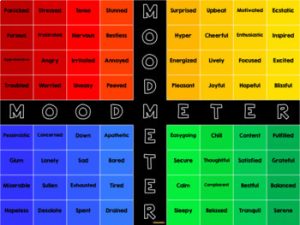 Since we began in September, a large part of our routine has been learning about our emotional wellbeing during Mindful Mornings. We have been using the Mood Meter, to help us identify
Since we began in September, a large part of our routine has been learning about our emotional wellbeing during Mindful Mornings. We have been using the Mood Meter, to help us identify and plot our emotions as well as the emotions of others on our chart to help us to better understand different strategies to calm and refocus our bodies. We also brainstormed different strategies others could use to also allow them to regulate. On Friday, we read Many Shapes of Clay: A Story of Healing to learn more about the emotion disappointment and the strategies we can use to overcome the challenging situations that may arise when we are feeling this way. In the story Eisha, creates a symbol to represent her most joyful memory out of clay. Our class also made symbols to showcase a joyful memory. See a few examples below created out of playdough!
and plot our emotions as well as the emotions of others on our chart to help us to better understand different strategies to calm and refocus our bodies. We also brainstormed different strategies others could use to also allow them to regulate. On Friday, we read Many Shapes of Clay: A Story of Healing to learn more about the emotion disappointment and the strategies we can use to overcome the challenging situations that may arise when we are feeling this way. In the story Eisha, creates a symbol to represent her most joyful memory out of clay. Our class also made symbols to showcase a joyful memory. See a few examples below created out of playdough!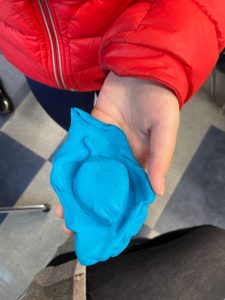 ” A memory that makes me feel joyful is finding different coloured leaves on the beaches with my family.”
” A memory that makes me feel joyful is finding different coloured leaves on the beaches with my family.” ” This is my snake. He always makes me feel happy when I am upset. We always have fun together.”
” This is my snake. He always makes me feel happy when I am upset. We always have fun together.”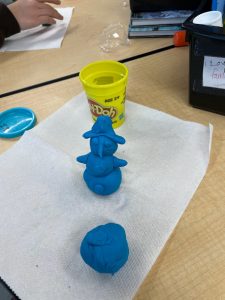 ” My family and I go outside and we make snowmen together every winter. This is a memory that makes me joyful.”
” My family and I go outside and we make snowmen together every winter. This is a memory that makes me joyful.”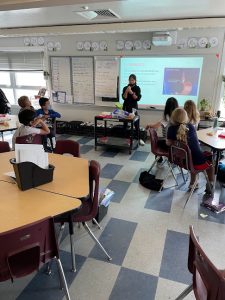 In Science, we have been learning all about the human body! The first system we are exploring is the digestive system. Recently, we conducted an experiment to discover how food travels through our bodies. We recreated this process using bananas, crackers, orange juice, and water and used a plastic bag to mimic our stomachs. We then used some panty hose to act as our intestines. Needless to say it was a very messy process. Watch our video
In Science, we have been learning all about the human body! The first system we are exploring is the digestive system. Recently, we conducted an experiment to discover how food travels through our bodies. We recreated this process using bananas, crackers, orange juice, and water and used a plastic bag to mimic our stomachs. We then used some panty hose to act as our intestines. Needless to say it was a very messy process. Watch our video 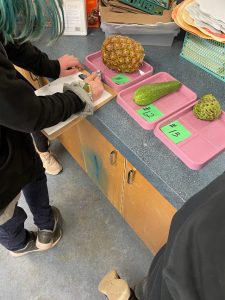 around our world! We put on our scientist hats and used our expert observational skills to record and measure what our fruits and vegetables looked like on the outside. We then predicted what
around our world! We put on our scientist hats and used our expert observational skills to record and measure what our fruits and vegetables looked like on the outside. We then predicted what 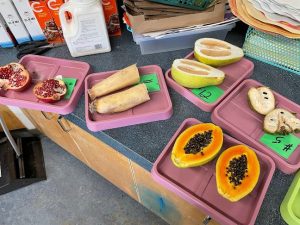 they would look like on the inside! Many of these fruits and vegetables are important to various cultures so we made sure to be respectful toward all of the foods we were not familiar with. Some food items included the mangosteen from tropical areas surrounding the Indian Ocean like Thailand and the mo qua from China. We did not get to try these fruits and veggies due to potential allergies but feel free to enjoy them at home or learn more about them through the video below!
they would look like on the inside! Many of these fruits and vegetables are important to various cultures so we made sure to be respectful toward all of the foods we were not familiar with. Some food items included the mangosteen from tropical areas surrounding the Indian Ocean like Thailand and the mo qua from China. We did not get to try these fruits and veggies due to potential allergies but feel free to enjoy them at home or learn more about them through the video below! debating which map we felt was the most accurate, we watched a short video clip (
debating which map we felt was the most accurate, we watched a short video clip (